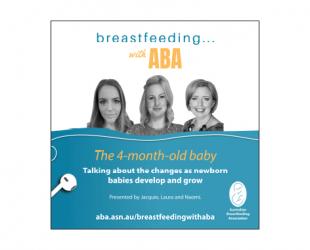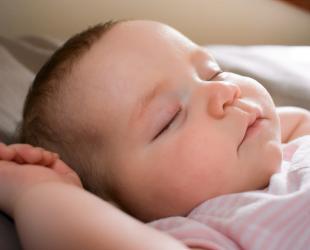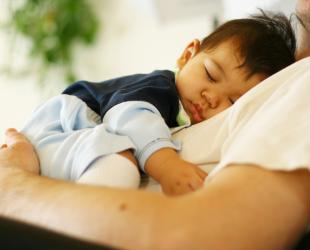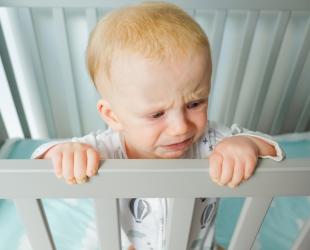Learn how to co-sleep safely while supporting breastfeeding and better sleep for everyone.
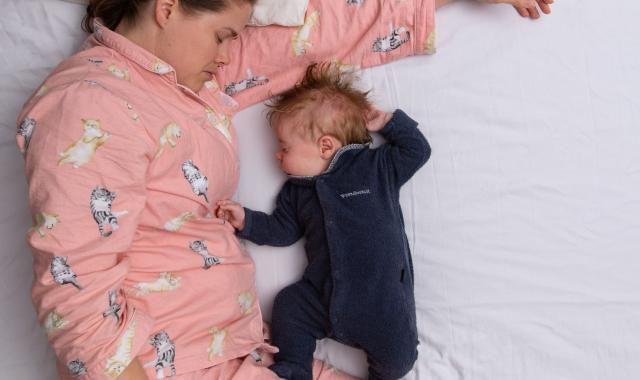
Co-sleeping – when a parent or caregiver shares a sleep surface with their baby – is more common than you might think. In fact, about 75% of Australian babies spend some time co-sleeping in their first 3 to 6 months.1,2
Many parents find that bringing their baby into bed at night makes feeding and caring easier and helps everyone get more rest.3
It’s recommended that babies sleep in their own sleep space, like a cot or bassinet, next to your bed for the first 6 to 12 months.4 Still, many families choose to share a bed or sometimes have no other option.1,2
It’s not just sharing a bed that’s risky. Other factors can make co-sleeping unsafe and increase the risk of sudden unexpected death in infancy (SUDI).5,6 So what’s important is understanding how to make co-sleeping as safe as possible.
Why breastfeeding and co-sleeping work together
Babies need to be fed during the night and many new mums fall asleep while feeding their baby. Co-sleeping helps to minimise disruption to sleep for both mum and baby.7 Breastfeeding and co-sleeping often go hand in hand. Feeding at night is easier when your baby is close, and many mums find their breastfeeding journey continues for longer when they co-sleep.8
Breastfeeding has a protective effect against sudden unexpected infant deaths (SUDI)
There are several theories as to why breastfeeding helps protect babies from SUDI:
- Breastfed babies are more easily woken up than formula-fed babies at 2 to 3 months of age, which is the age when SUDI occurs most often.10
- Breastfeeding provides important immune factors like antibodies and white blood cells, which may help protect babies.11
- Fewer infections: Some babies who die suddenly and unexpectedly have had a minor infection in the days before, but it wasn’t considered enough to cause death on its own. Breastfed babies tend to have fewer infections than formula-fed babies.11
How breastfeeding mums co-sleep safely
You might feel unsure about co-sleeping with your baby. However, research shows that breastfeeding mums who co-sleep often do things that naturally help keep their baby close and safe:
- The breastfeeding mum usually forms a protective “C” shape around their baby. She keeps her baby at the level of her breast with an arm between her baby's head and the pillow.
- She instinctively bends her legs, creating a protective space around the baby. This makes it almost impossible for someone else to roll onto the baby without first touching her legs.12
- Breastfeeding mums who co-sleep tend to be highly responsive to their baby’s needs – unless they’ve had alcohol, taken illegal or sleep-inducing drugs, or are extremely tired.13
- Mums and babies who co-sleep often wake more during the night. This may help protect against sudden unexpected infant deaths, as mums check on and breastfeed their babies more frequently than when room-sharing.14,15
Risks to be aware of
Certain situations increase the risk of SUDI when co-sleeping:
- Smoking: If you or your partner smoke, or smoked during pregnancy, never co-sleep with your baby.
- Alcohol, drugs, or extreme tiredness: These can make it unsafe to co-sleep.
- Other people or pets in the bed: Babies should only share a sleep surface with a parent, not siblings or pets.
- Formula feeding: Formula-fed babies are safer sleeping in their own space next to your bed.
- Sofas and armchairs: Never sleep with your baby on a sofa or armchair. This is very dangerous.
- Overheating or head covering: Make sure your baby doesn’t get too hot or have their head covered.
- Leaving baby alone on an adult bed: Babies should never be left unattended on an adult bed.
Tips for safer co-sleeping
Red Nose provides the following tips if you choose to co-sleep:
- Always put your baby to sleep on their back.
- Use a firm, flat mattress.
- Create a clear sleep space for baby to sleep. Place baby to the side of one parent – never in the middle of two adults or next to other children or pets.
- Use a safe sleeping bag with no hood and baby’s arms out. Don’t wrap or swaddle baby.
- Make sure baby can’t fall off the bed. Move the bed away from the wall so baby can’t get trapped between the bed and the wall.
- Avoid electric blankets and keep pillows, doonas, and sheets away from your baby.
- Keep your baby’s head uncovered.
- Tie up long hair and remove all jewellery including teething necklaces.
Flyers and factsheets
Australian Breastfeeding Association and Red Nose downloadable resources
Other sites and information
Red Nose: Safe sleeping guide
Red Nose: Safer co-sleeping guide
Caring for your baby at night and when sleeping – UNICEF
Dr James McKenna’s website
- Rigda RS, McMillen IC, Buckley P 2000, Bed sharing patterns in a cohort of Australian infants during the first six months after birth, J. Paediatr Child Health 36: 117-121. https://doi.org/10.1046/j.1440-1754.2000.00468.x
- Cole R, Young J, Kearney L, Thompson J 2020, Infant care practices and parent uptake of safe sleep messages: a cross-sectional survey in Queensland, Australia. BMC Pediatr 20:27. https://doi.org/10.1186/s12887-020-1917-5
- Ball, H.L 2002, Reasons to bed-share : why parents sleep with their infants, Journal of reproductive and infant psychology, 20 (4):207-222.
https://doi.org/10.1046/j.1523-536X.2003.00243.x - Red Nose. (n.d.). Co-sleeping with your baby. Retrieved from https://rednose.org.au/article/Co-sleeping_with_your_baby
- Carpenter, R.G., Irgens, L.M., Blair, P.S., et al 2004, Sudden unexplained infant death in 20 regions in Europe: case control study. Lancet. 363,185-191. https://doi.org/10.1016/s0140-6736(03)15323-8
- Vennemann, M.M., Hense, H.W., Bajanowski, T., et al 2012, Bed Sharing and the risk of sudden infant death syndrome: can we resolve the debate? Pediatr. 160(1),44-48.e2. https://doi.org/10.1016/j.jpeds.2011.06.052
- Mosko, S., Richard, C., McKenna, J 1997, Maternal sleep and arousals during bedsharing with infants. Sleep. 20(2),142-150. https://doi.org/10.1093/sleep/20.2.142
- Blair, P.S., Heron, J., Fleming, P.H 2010, Relationship between bed sharing and breastfeeding: Longitudinal, population-based analysis Pediatrics 126(5): e1119-e1126. https://doi.org/10.1542/peds.2010-1277
- McKenna J.J., Mosko, S.S 1997, Bedsharing promotes breastfeeding, Pediatrics. 100(2 Pt 1),214-219.
- Horne, R.S., Parslow, P.M., Harding, R 2004, Respiratory control and arousal in sleeping infants Paediatr Respir Rev. 5(3),190-198. https://doi.org/10.1016/j.prrv.2004.04.011
- Sankar, M.J., Sinha, B., Chowdhury, R., Bhandari, N., Taneja, S., Martines, J., Bahl, R (2015), Optimal breastfeeding practices and infant and child mortality: a systematic review and meta-analysis. Acta Paediatr 104(467),3-13. https://doi.org/10.1111/apa.13147
- Young, J 1999, Night-time behaviour and interactions between mothers and their infants of low risk for SIDS: a longitudinal study of room-sharing and bed sharing, PhD thesis: Institute of Child Health, University of Bristol.
- McKenna, J.J., McDade, T (2005). Why babies should never sleep alone: a review of the co-sleeping controversy in relation to SIDS, bedsharing and breast feeding. Paediatr Respir Rev. 6(2),134-152. https://doi.org/10.1016/j.prrv.2005.03.006
- Mosko, S., Richard, C., McKenna, J 1997, Maternal sleep and arousals during bedsharing with infants. Sleep. 20(2),142-150. https://doi.org/10.1093/sleep/20.2.142
- Baddock, S.A., Galland, B.C., Bolton, D.P., Williams, S.M., Taylor, B.J 2006, Differences in infant and parent behaviors during routine bed sharing compared with cot sleeping in the home setting. Pediatrics. 117(5),599-1607. https://doi.org/10.1542/peds.2005-1636
© Australian Breastfeeding Association January 2026
